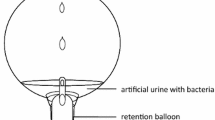Summary
Twenty-seven patients with indwelling urinary catheters and chronic bacteriuria were studied for methenamine efficacy. In a crossover fashion, each patient received methenamine mandelate granules 4 g/day alone, with ascorbic acid 4 g/day, and with ascorbic acid 4 g/day plus cranberry cocktail one l/day.Proteus vulgaris, Pseudomonas aeruginosa, andE. coli were the common pathogens. Urinary acidifiers had no significant effect on mean urine pH, however, high urinary formaldehyde concentrations were associated with the use of ascorbic acid. Bacteriocidal formaldehyde levels were more frequently present in patients with acidic urine pH than those with alkaline pH. Although ascorbic acid increased formaldehyde levels, additional cranberry cocktail had no further effect. Despite higher formaldehyde levels, urine culture results were positive in most cases with or without urine acidification. Methenamine therapy may be of limited value in asymptomatic chronic bacteriuric patients with indwelling catheters.
Similar content being viewed by others
References
Carroll G, Allen HN (1946) The treatment of urinary infections with mandelamine (methenamine mandelate); a clinical study of 200 cases. J Urol 55: 674–681
Freeman RB, Bromer L, Brancato F et al. (1968) Prevention of recurrent bacteriuria with continuour chemotherapy. Ann Int Med 69: 655–672
Gerstein AR, Okun R, Bonick HC et al. (1968) The prolonged use of methenamine hippurate in the treatment of chronic urinary tract infections. J Urol 100: 767–771
Harding GK, Roland AR (1974) A controlled study of antimicrobial prophylaxis of recurrent urinary infections in women. N Engl J Med 291: 597–601
Holland NH, West CD (1963) Prevention of recurrent urinary tract infections in girls. Am J Dis Child 105: 560–567
McDonald DF, Murphy GP (1959) Bacteriostatic and acidifying effects of methionine, hydrolyzed casein, and ascorbic acid on the urine. N Engl J Med 261: 803–806
Murphy FJ, Zelman S (1965) Ascorbic acid as a urinary acidifying agent, 1: comparision with ketogenic effect of fasting. J Urol 94:297–299
Murphy FJ, Zelman S, Mau W (1965) Ascorbic acid as a urinary acidifying agent, 2: its adjunctive role in chronic urinary infections. J Urol 94: 300–305
Travis LB, Dodge WF, Mintz AA et al. (1965) Urinary acidification with ascorbic acid. J Pediatr 67: 1176–1178
Nahata MC, Shimp L, Lampman T, McLeod DC (1977) Effect of ascorbic acid on urine pH in man. Am J Hosp Pharm 34: 1234–1237
Fellers CR, Redmon BC, Parrott EM (1933) Effect of cranberries on urinary acidity and blood alkali reserve. J Nutr 6: 455
Bodel PT, Cotran R, Kass EH (1959) Cranberry juice and the antibacterial action of hippuric acid. J Lab Clin Med 54: 881–888
Nickey KE (1975) Urine pH: Effect of prescribed regimen of cranberry juice and ascorbic acid (Abstract). Arch Phys Med Rehab 56: 556
Knight V, Draper JW, Brady EA et al. (1952) Methenamine mandelate antimicrobial activity, absorption and excretion. Antibiot Chemother 2: 615
Musher DM, Griffith DP (1974) Generation of formaldehyde from methenamine: effect of pH and concentration, and antibacterial effect. Antimicrob Agents Chemother 6: 708–711
Scudi JV, Duca CJ (1949) Some antibacterial properties of mandelamine (methenamine mandelate). J Urol 61: 459
Vainrub B, Musher DM (1977) Lack of effect of methenamine in suppression of, or prophylaxis against chronic urinary infection. Antimicrob Agents Chemother 12: 625–629
Chen TM, Chafetz L (1972) Selective determination of free urinary formaldehyde after oral dosage with methenamine mandelate. Invest Urol 10: 212–214
Pearman JW, Peterson GJ, Nash JB (1978) The antimicrobial activity of urine of paraplegic patients receiving methenamine mandelate. Invest Urol 16: 91–98
Newton DW, Kluza RB (1978) pka values of medicinal compounds in pharmacy practice. Drug Intell Clin Pharm 12: 546
Windholz M (1976) (Ed): The Merck Index 9th Ed., Rahway NJ, p 845 and 6744
Musher DM, Griffith DP, Ritchie Y (1976) Generation of formaldehyde from methenamine — effect of urinary flow and residual volume. Invest Urol 13: 380–382
Author information
Authors and Affiliations
Rights and permissions
About this article
Cite this article
Nahata, M.C., Cummins, B.A., McLeod, D.C. et al. Effect of urinary acidifiers on formaldehyde concentration and efficacy with methenamine therapy. Eur J Clin Pharmacol 22, 281–284 (1982). https://doi.org/10.1007/BF00545228
Received:
Accepted:
Issue Date:
DOI: https://doi.org/10.1007/BF00545228




